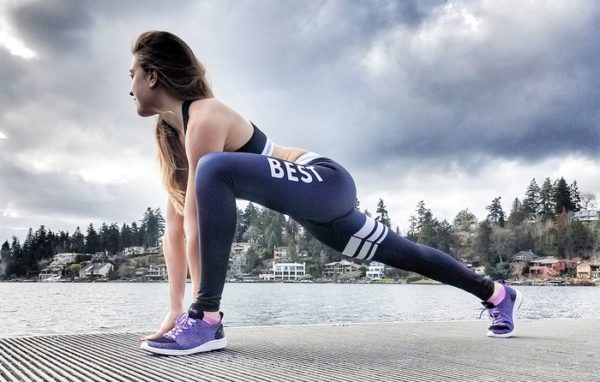Running is a great tool for when you need help getting into shape. Anyone who falls in love with running knows it can be pretty addicting (in a good way), but regardless of how much you do it, it taxes your body in a major way.
To counter that, you need to implement good preventative and recovery strategies, so you can run faster and optimize your endurance. The high impact and repetitive motion of feet to pavement can leave you with aching joints. Yoga can help restore your mind and also aid your recuperation and keep you in top shape.
You have probably heard that yoga is an awesome tool for pre-and post-running sessions, but you may not know that it can also lend itself to correcting technique and reducing muscle fatigue. That means better run times! There are certain movements that will benefit all runners in general and some that you should be focusing on.
Here are some of my favorite poses that all runners can incorporate into their warm-up and post-run recovery sessions, no matter their style or training routine. Hold each pose for 3-5 deep breaths. Grab your yoga mat and get posing!
Anjaneyasana: Runner’s Lunge:

Runner’s lunge is one of the best active-stretching yoga poses for runners; hence the name. Using multiple muscles at once, it can be a great pre-run warm-up as well as a post-run recovery movement.
Although it seems that your hamstrings are doing all the work, the hip flexors and quads are heavily involved as well, which is important as they both take quite a beating from pounding the pavement. Make sure your leg is straight and strong and your quad is active, and keep your chest open. You want to use your breath to get deep in the pose and enjoy the stretch!
Related article: 9 Benefits of Running That Make You Healthier Fitter And Insanely Sexy
Trikonasana: Triangle Pose:

Triangle pose is one of the best hip openers and hip flexor stretches, and it includes a slight twist, giving you a great lower back release after a long run. Activating your quads as you hold the pose will protect the hamstrings from getting overstretched.
Use every inhale to enhance the stretching out of the spine, and use the exhales to go deeper into the twist. This is a yoga pose you will definitely feel in your whole body, from shoulders and obliques to glutes and hamstrings.
Related article: 5 Stretches In 5 Minutes – Prime Your Muscles For A Safer, More Efficient Walk Or Run
Ustrasana: Camel Pose:

Camel pose is amazing for stretching out the quads and hip flexors as you push your hips forward. You can control how deep you want to go and protect your lower back by growing tall with every inhale. Lifting your hands over your head can help you avoid over compressing the lower back.
Running really tightens up the front of the body, and the camel pose works better than your regular wheel pose, as you can isolate the quads, hip flexors, and abs to give your front half some major relief.
Related article: 5 Super Strength Exercises for Runners
Marichyasana: Seated Twist:

All twists are useful, as they help bring fresh oxygen into the muscles, but this seated twist is one of my favorites. You can actively work on stretching out your lower back by sitting taller with every exhale and feel yourself “growing from your sitting bones.”
As always, you control how deep you want to go. It can feel so satisfying after all that strictly forward motion in a tough run. You can also do this lying down, but I prefer the sitting-up version, as it’s more active than passive and you get to focus on the depth of the pose.
Related article: Both Swimming And Running Are Known To Be Good For Weight Loss, But Which Is The Best?
Ado Mukha Svanasana: Downward-Facing Dog:

The absolute yoga staple! This is one of those poses you can use anytime, anywhere, to warm up and loosen up your body—for any movement, even to stretch out your legs after a long airplane ride.
It stretches out the spine, back muscles, shoulders, hamstrings, and calves—all of which take major hits on a runner! You can make it as dynamic or as passive as you want, depending on whether you’re looking for improved mobility before your run or using it for recovery after.

